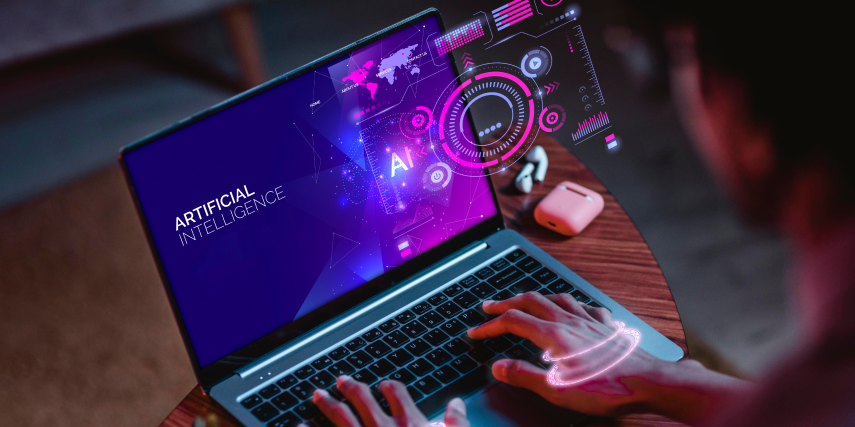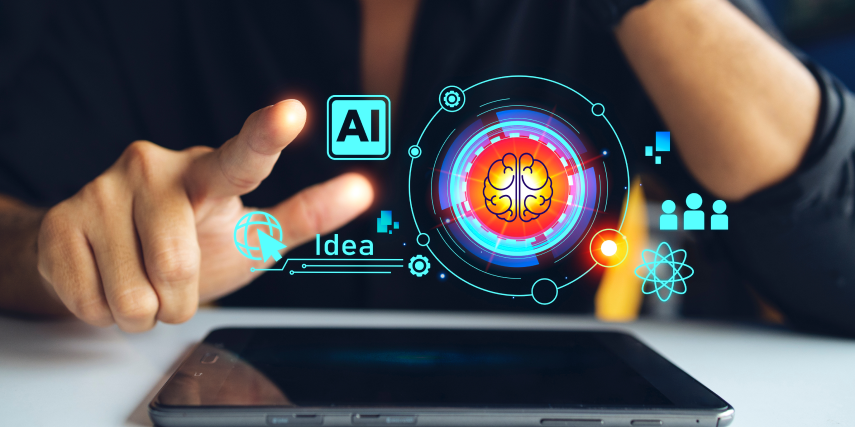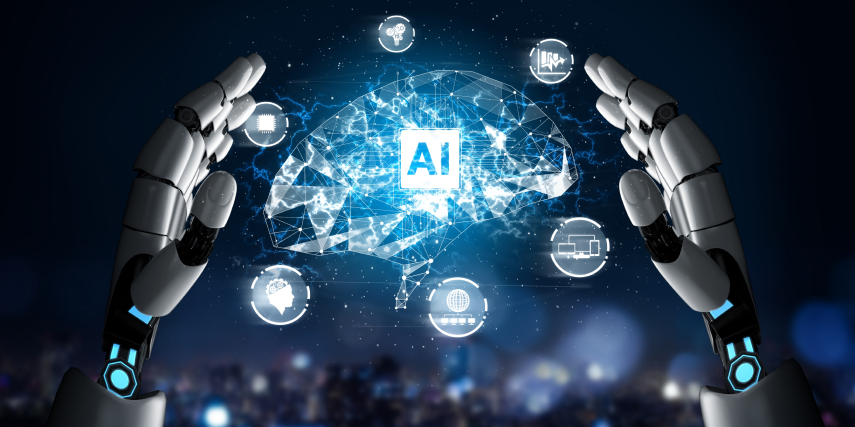How can UI/UX Designers Effectively Use AI to Improve Their Design Work?
October 9, 2023

Artificial Intelligence is continuously influencing various business frontiers with its extraordinary capabilities. The design industry is not an exception. The impact of Artificial intelligence has triggered several jobs of designers due to its heavy usage in improvising creativity.
The fact is that AI works as a catalyst helping users to get through the targets. People have different perspectives regarding AI. Currently, it works as an augmented magic trick strengthening designers to create exceptional designs.
Now, how can we incorporate such magic tricks into our designing practices and how can we create stunning designs driven by AI?
The below blog answers not only the above question but also will give you insights on several ways of using AI in your UI/UX design practices. So let us address all your concerns.
What Level of Accuracy Does AI Provide in UI/UX Design?
The entire story of AI is based on algorithms that are created by humans. And no man in this world is perfect. With that, even AI can tend to goof up at initial levels. So, make sure before incorporating AI insights into your projects, you fast-check every suggestion and information that AI provides you. However, you can always rely on Google search for cross-checking and getting more insights. To be precise, if you are looking to work on a large-scale project, AI proves to be a good companion for research and design. And if that does not work, quality research with the traditional internet is the best option any day.
Top Use Cases That Prove Effective Use of AI in UI/UX Design
Integrating Empathy in Designs
The role of creating empathetic UX is to catch the real emotions of the users as it is a promising way to make them stay in your app for a longer time. When businesses fail to understand its impact, AI comes in. Automation is no more a challenge for companies. With AI design tools that support a variety of emotions, training machines can perform redundant tasks effortlessly. Incorporating human values via designs can become the routine UX design practice enhancing user interactions. Moreover, integrating various AI emotional apps using facial recognition and expressions can also improve designs to a great extent.
Improving Productivity with Automation
Design process automation enables UI/UX designers to work seamlessly on their designs. Repetitive tasks can be automated by using pattern recognition tools that will collect design pieces, validate the data, and suggest several design patterns. AI-powered tools and techniques adapt to the changes quickly and hence designers can quickly generate several design concepts. Even the entire documentation process and laborious tasks can be automated enabling higher levels of design efficiency.
Personalization and Data-driven Decisions
Data monitors the entire web world. We live in a world where tons of data and information are generated every day. So data only empowers your decision-making process. Designers leverage crucial data by analyzing user behaviors generated by AI-driven analytics. User behavior differs because of their distinct choices. However, some things remain common and that helps in making several decisions. The insights captured through data analytics on user choices and behaviors assist in understanding user preferences and dislikes while scrolling the screen. With the study done on each user behavior, organizations can create solutions that are based on personalized user experiences, leading to higher conversions.
Creating Generative Designs for Design Inspiration
Tools like Canva suggest to users which design part can be chosen next. Similarly for other AI-based design tools, you need to just mention the parameters that will provide you with creative design suggestions. However, Canva is not completely AI-driven but still can assist designers in incorporating creative designs into their presentations. Similarly, numerous tools help users improve their designs by sharing their current designs. So designers may not get a ready platter, leaving them with many suggestions and design insights from AI tools to work with.
Information Architecture (IA)
With Information Architecture, you can beautify and navigate your digital products by using apps that will comfort the users. The impact of IA has enabled designers to harness the capabilities of several AI models that are user-centric, can establish patterns, and can create stunning visuals and much more.
Product Iterations and Rapid Prototyping
Building an ideal digital product prototype is the most crucial job of a UI/UX designer. It takes longer time than usual sometimes as it involves a lot of market research and analysis. But with AI tools on the table, you get better alternatives with a rough idea along with certain parameters that will help you create exceptional prototypes. AI-powered prototyping tools provide designers with suggestions, and inspiration, and can save time and money. Designers can rapidly pass through the ideation process, build raw design pieces, and share it with AI to obtain ideas leading to several iterations. In this way, designers can save a lot of time.
Product Writing
Several design tools help designers build wireframes, that have several pieces of content to be written. Instead of putting ‘lorem ipsum’, designers can now get insights from content tools like ChatGPT, Bard AI, Jasper AI, etc. to get a meaningful product copy making users understand everything about design and its functions.
Usability and Accessibility Testing
AI tools help UI/UX designers to analyze their designs through diverse methods. One of them is usability and accessibility testing. Some popular tools like Visualeyes conduct user-centric tests that focus mainly on design patterns and user behavior. With similar tools, designers get inspiration for creating designs for visually disabled people or those who are color blind. With such tools, they can access several color schemes and navigation tools.
Top 5 Practices to Incorporate AI in UI/UX Design

It is suggested not to rely completely on AI for creating better UI/UX designs, however, you can use the below practices:
Rigorous research on users
AI tools will provide comprehensive feedback on user traits and user behavior. UX researchers can create exceptional designs by analyzing the data and understanding patterns. With popular AI tools like Google Analytics, UserTesting, and Hotjar, and by keeping an eye on the heat maps, you can find out where the users stop and where they stay.
Finding the right AI-powered tool
Creating a unique design requires abundant research not only on the user statistics but also while choosing AI-powered tools. From user research to user testing, you must find the right tool that will help you cover the purpose of creating designs.
Make iterations with AI feedback
Test and analyze the raw design samples into your AI tools as they will give you feedback on your design patterns along with suggestions to enhance the visual appeal and accessibility. You can also obtain data-driven guidance to enhance your design speed and deliver prototypes at a faster pace.
Incorporate Human Creativity and balance AI suggestions
AI can only provide you with suggestions and relevant information. As mentioned earlier, relying on AI completely can be hazardous. Before using any AI-powered information, you must cross-check by researching on your own and by using your design instincts. Machines also tend to make mistakes, as they are designed by humans. The best design would be a subtle combination of AI and human intelligence with a perfect blend of creativity that human influences at a larger scale.
Stick to ethics while using AI
Relying totally on AI can hamper the authenticity and value of your designs. Despite being beneficial in several ways, you must always keep your stakeholders in the loop about how you are using AI for developing designs. As a designer, this gesture will reflect your professionalism and ethics.
Best 5 AI-powered Design Tools in 2023

Adobe Sensei
- Can create photorealistic effects, editing photos and videos rapidly
- Optimizes and scales design experiences with real-time intelligence
- Provides deep insights, and real-time decisions and can predict customer behavior
- Can provide personalized customer experiences and workflow accelerations
Khroma
- Assists in selecting the right color palette based on your choice of colors
- Creates and provides different font color types on particular colors and poster colors
- Will suggest image editing with different color overlays
- It generates results based on 50 biases that are your favorite colors
Adobe Firefly
- It has a fill feature that will allow you to change the background pictures and image sections with a realistic image feel
- Has a prescribed process to fill the new element into the design
- Allows you to create images that can be used for your UI/UX design and social media campaigns.
Uizard
- This tool empowers designers to seamlessly create UI/UX designs.
- Beginner-level designers can create stunning visuals with this tool with a specific process
- Also, you can upload a rough wireframe idea into the app and get an accurate visual representation of that screen
VisualEyes
- It is like Grammarly analyzes content into the UI designs simulates eye-tracking studies with preference tests and provides accuracy levels
- Testing happens in three categories namely, Attention Map, Clarity Score, and Areas of Interest.
- You can perform A/B testing for your design options, analyze areas where users stay for more time, create valid design assumptions, and make visually attractive UI/UX designs
Problems While Creating AI-driven UI/UX Designs

No Control
Real designers wait to buy the ideas and suggestions of AI. And if they do, they somehow feel unsatisfied because designing is a task that gets completed only when you pour your years of experience into each nuance of the design-making process.
Biased
AI tools are trained and technology-driven. It relies on biased datasets and creates designs that may look quite stereotypical. To create innovative designs, you must think from the user’s perspective and make sure the designs are user-friendly and accessible.
No Human Creativity
Numerous algorithms and training datasets work behind every AI tool. Hence, each of these tools cannot be interpreted completely like humans in terms of critical thinking and empathy. To shun away from making your design tools more robotic, you must use them only following your design skills ensuring you get better conversions.
Technology Dependent
It is obvious that AI tools will save you time and can create many design tasks. However, the fear remains of too much reliance on technology over human intelligence. This may become lethal for designers and can hamper creativity and innovation.
How Can Softqube Technologies Assist You in Crafting Stunning UI/UX Designs?

AI will stay here for several decades and will keep evolving. However, it is impossible to beat human creativity with AI. Designers can use it as an assistant to create responsive user interfaces enabling saving on time and effort. At Softqube Technologies, we have a robust team of UI/UX designers who challenge AI to create outstanding designs. Our digital products give stunning user experiences driving the users to come back and access the designs.
Are you up with unique digital product ideas? Get in touch with us, our UI/UX designers are keen to help you transform it into a fully-featured digital product that will add value to your user’s needs.








